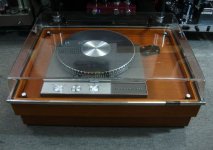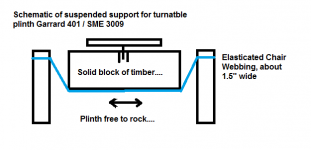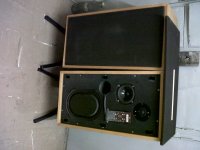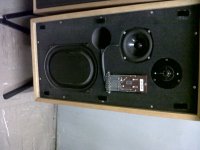The B110 came in two versions. The SP1003 and the SP1057 (I think). They had slightly different characteristics and LS3/5a's using them had crossover variations to suit. Original BBC LS3/5a's were apparently individually adjusted to compensate for driver variations. It would seem that consistency between batches was a problem back then.
Was SP1057 ever used in LS3/5A?
dave
I know the SP1057 was used in many Kef models like the 105 and 101. It was the SP1228 used in later Ls3/5a models around 1987.Was SP1057 ever used in LS3/5A?
dave
Hi everyone.
Just an update. re:- the Kef units.
I've prepared them ready for the install in new cabinets. Carefully cleaned up the units individually.
They are in a really good condition.
Another question please ?
Is there a specific are on this brilliant site that i can ask about my Garrard 401 ?
It makes a very quiet hum from the motor running ? - nothing annoying when music is playing, but nevertheless, I dont think its right ?
I havent maintained / serviced it yet ( this too was kindly donated to me ) . It sits in an 18mm plinth, and is perched on my Technics tower unit, that I have temporarily removed the glass lid from.
Garrard 401 experts, please help
Thanks and kind regards
adrian
Just an update. re:- the Kef units.
I've prepared them ready for the install in new cabinets. Carefully cleaned up the units individually.
They are in a really good condition.
Another question please ?
Is there a specific are on this brilliant site that i can ask about my Garrard 401 ?
It makes a very quiet hum from the motor running ? - nothing annoying when music is playing, but nevertheless, I dont think its right ?
I havent maintained / serviced it yet ( this too was kindly donated to me ) . It sits in an 18mm plinth, and is perched on my Technics tower unit, that I have temporarily removed the glass lid from.
Garrard 401 experts, please help
Thanks and kind regards
adrian
Always pleased to hear about an enthusiast fixing up an old classic. There's terrific web support for the older KEF models, so you won't go far wrong.
With that Garrard 401, you have quite an impressively great retro system in the making. It's a great and beautiful and collectable turntable with spare parts available. The round rubber idler wheel connecting the motor to the rim is known to produce more bass rumble than a belt drive. But its part of the design, and you just live with it.
Enthusiasts generally use a very heavy wooden plinth and some serious acoustic isolation like webbing straps on a most solid shelf well away from the speakers.
With that Garrard 401, you have quite an impressively great retro system in the making. It's a great and beautiful and collectable turntable with spare parts available. The round rubber idler wheel connecting the motor to the rim is known to produce more bass rumble than a belt drive. But its part of the design, and you just live with it.
Enthusiasts generally use a very heavy wooden plinth and some serious acoustic isolation like webbing straps on a most solid shelf well away from the speakers.
Sorry, my mistake. It was the SP1228 (B110C) in the LS3/5a's of later years, and it did have somewhat different characteristics. I was originally thinking of the CS1 and CS1a (constructor series) which also used the T27 and B110 combo. I have a pair of LS3/5a clones using SP1003 drivers. While I do quite like their sound they are a bit harsh at times and they really are a near field monitor. They tend to become a bit shouty if pushed beyond their limit.Was SP1057 ever used in LS3/5A?
dave
Thankyou for the replies, after doing much research, and this forum, I'm considering housing the speakers in enclosed , tight boxes, ( not xmission line ) and use plenty of Baff wadding, or whatever the equivalent is. - going for relatively tall slim , rather than the dimension of the boxes they came out of. - so the B139, will be vertical as it were, then B110 above, then T27 at top. That should do it. Some KEF data sheets have given me volumes required for the bass and the mid units, so i'll isolate each chamber, and dampen them well, this will also help in strengthening the cabs too . -
The Garrard 401, - weighs a ton , but i will have a peek at it sometime. Like you said steve, its the design, I think when i looked yesterday, the noise is off the actual motor, with the platter removed , and carefully disengaging the idler, there was no difference, so the noise is transmitting from motor , through the body of turntable, into plinth. - my towe unit doesnt help, its acting like a sound chamber a bit .... - its there very temporarily, to prove it works, but safe so it wont slide off it ...
The Garrard 401, - weighs a ton , but i will have a peek at it sometime. Like you said steve, its the design, I think when i looked yesterday, the noise is off the actual motor, with the platter removed , and carefully disengaging the idler, there was no difference, so the noise is transmitting from motor , through the body of turntable, into plinth. - my towe unit doesnt help, its acting like a sound chamber a bit .... - its there very temporarily, to prove it works, but safe so it wont slide off it ...
There is a slight pitfall do consider when you make a cabinet narrower where the speaker is away from the wall. It changes the bafflestep point. This is where the driver is half a wavelength to the edge of the cabinet, at which point you transition from 4Pi space to 2Pi space. Oh look, I can't explain it simply here beyond saying that when you pull a speaker away from the wall, the bass falls 6dB up to the bafflestep point. 
Loudspeaker Diffraction Loss and Baffle Step Compensation Circuits
Bottom line is narrower cabinets need a bigger bass coil and you then attenuate the midrange and tweeter to compensate. My own preference is to sidestep the issue entirely and build bookshelf style flush with the wall.
The Garrard 401 is quite familiar to me. People used to build them into cabinets or make their own plinth from a lump of wood. SME made a goodish suspended plinth, but the best I ever saw was suspended on furniture webbing within a simple box frame so it rocked gently backwards and forwards while tracking securely. The flimsy SME 3009 9" tonearm wasn't really all that good in hindsight, and people fitted heavier ones with the more demanding moving coil cartridges.
Loudspeaker Diffraction Loss and Baffle Step Compensation Circuits
Bottom line is narrower cabinets need a bigger bass coil and you then attenuate the midrange and tweeter to compensate. My own preference is to sidestep the issue entirely and build bookshelf style flush with the wall.
The Garrard 401 is quite familiar to me. People used to build them into cabinets or make their own plinth from a lump of wood. SME made a goodish suspended plinth, but the best I ever saw was suspended on furniture webbing within a simple box frame so it rocked gently backwards and forwards while tracking securely. The flimsy SME 3009 9" tonearm wasn't really all that good in hindsight, and people fitted heavier ones with the more demanding moving coil cartridges.
Attachments
Last edited:
Steve ,
I'll seriously look into that and thanks for the link re :- diffraction loss etc.
looking forward to researching, to get it right.
I'm up to speed with dB's , its my job ( in communications ) and I have a very very small electronics construction business . anyway , cant wait to get the old log tables out ( nah, scientific calculator. )
Just been looking at some Slate plinths for the 401 - ( well ... I can dream can't i )-
re the narrow cab, -- still would have depth behind the woofer, but just making them leaner ?? that was all
I'll seriously look into that and thanks for the link re :- diffraction loss etc.
looking forward to researching, to get it right.
I'm up to speed with dB's , its my job ( in communications ) and I have a very very small electronics construction business . anyway , cant wait to get the old log tables out ( nah, scientific calculator. )
Just been looking at some Slate plinths for the 401 - ( well ... I can dream can't i )-
re the narrow cab, -- still would have depth behind the woofer, but just making them leaner ?? that was all
Recently I moved from Holland to the USA. With me I took the drivers and filters of the KEF Concertos. The home-made casing was too bulky so I stripped it. So I have more or less the same question as the original poster.
I want to rebuild the system but with a smaller cabinet. I like to make a smaller (less wider) cabinet in a closed form. I don't mind to lose some of the low frequencies. Is a box of about 300 mm wide reasonable?
The original box was about 70 to 75 liter with a port. What could be the size of a fully closed cabinet?
In Holland I knew my way for damping material and electronic components. Which companies are delivering the stuff?
I want to rebuild the system but with a smaller cabinet. I like to make a smaller (less wider) cabinet in a closed form. I don't mind to lose some of the low frequencies. Is a box of about 300 mm wide reasonable?
The original box was about 70 to 75 liter with a port. What could be the size of a fully closed cabinet?
In Holland I knew my way for damping material and electronic components. Which companies are delivering the stuff?
Hi guys
This week I finally got my pair of KEF Concertos. It was quite a good deal for me. I got the Concertos, a Lenco L-75 turntable, a pair of Seas H-087 tweeters and a trio of GE A1-501 16" tone-arms, all for the grand total of $135. I'm happy. The one T27 tweeter is not working, but the previous owner got a quote of $35 to fix it. I think I'm going to go down that route.
Ok, so I just got the speakers, and I am not even using them yet, but the DIY-and-tweaking bug has already bit. I have a pair of Leak Sandwich bass drivers, so I thought- why not go four-way. Put the B139 in an aperiodic sealed box, and use the Leak bass driver for low bass, XO at about 120Hz - 150Hz. I'll use the existing front baffle of the Concertos, just add a piece of baffle on the bottom end for the Leak driver, and then build a box around that. Sorta like the Concertos, just taller and with an extra bass driver on the bottom. The Leaks will each go into a sealed 2cu.ft. to 3cu.ft. cabinet. What I want to do is slightly improve on the aspect I suspect will be the weakest, namely the bass. I don't expect the bass to go much deeper, but with better quality and power handling. What do you guys think? Worth the trouble? Note that these speakers will not be keepers. I have a pair of Tannoy 15" dual-concentrics that need new surrounds. When they have been repaired, I'm going to pass the KEFs on to a friend of mine. They suit his types of music well (soft rock, ballads and vocals). I could have fixed the Tannoys for the money I spent on the KEF package deal, but the Lenco turntable called too hard. OTOH, I got such a good deal, if I had to choose again, I'd do it again at the drop of a hat. That all said, what do you guys think of my idea?
OTOH, I got such a good deal, if I had to choose again, I'd do it again at the drop of a hat. That all said, what do you guys think of my idea?
Enjoy,
Deon
This week I finally got my pair of KEF Concertos. It was quite a good deal for me. I got the Concertos, a Lenco L-75 turntable, a pair of Seas H-087 tweeters and a trio of GE A1-501 16" tone-arms, all for the grand total of $135. I'm happy. The one T27 tweeter is not working, but the previous owner got a quote of $35 to fix it. I think I'm going to go down that route.
Ok, so I just got the speakers, and I am not even using them yet, but the DIY-and-tweaking bug has already bit. I have a pair of Leak Sandwich bass drivers, so I thought- why not go four-way. Put the B139 in an aperiodic sealed box, and use the Leak bass driver for low bass, XO at about 120Hz - 150Hz. I'll use the existing front baffle of the Concertos, just add a piece of baffle on the bottom end for the Leak driver, and then build a box around that. Sorta like the Concertos, just taller and with an extra bass driver on the bottom. The Leaks will each go into a sealed 2cu.ft. to 3cu.ft. cabinet. What I want to do is slightly improve on the aspect I suspect will be the weakest, namely the bass. I don't expect the bass to go much deeper, but with better quality and power handling. What do you guys think? Worth the trouble? Note that these speakers will not be keepers. I have a pair of Tannoy 15" dual-concentrics that need new surrounds. When they have been repaired, I'm going to pass the KEFs on to a friend of mine. They suit his types of music well (soft rock, ballads and vocals). I could have fixed the Tannoys for the money I spent on the KEF package deal, but the Lenco turntable called too hard.
Enjoy,
Deon
Hi guys
Here are two photos of the old girls. They are on some open-frame stands I got with them. The veneer on both has become very tatty and loose, in fact I got a nasty splinter from the one the other day, so this is also part of the motivation to build new cabs. I did a quick calc, and I'd be able to put the Leaks in sealed cabs of about 75l - 80l. Maybe more if I extend the depth a bit. What do you think?
Deon
Here are two photos of the old girls. They are on some open-frame stands I got with them. The veneer on both has become very tatty and loose, in fact I got a nasty splinter from the one the other day, so this is also part of the motivation to build new cabs. I did a quick calc, and I'd be able to put the Leaks in sealed cabs of about 75l - 80l. Maybe more if I extend the depth a bit. What do you think?
Deon
Attachments
Hi there
Can anyone explain why, in the crossover schematic in Post 4, the B110 midrange is wired in inverse phase to the woofer and tweeter?
Ok, so since no-one seems to want to answer this one, I'll take a stab at it. Just note that I am not technical. As far as I understand it, it is due to the fact that the 2nd order crossover reverses phase at the crossover point. Therefore the phase of the mid is reversed to compensate. Others may have a better explanation.
Deon
Those Concertos are nice speakers.Hi guys
Here are two photos of the old girls. They are on some open-frame stands I got with them. The veneer on both has become very tatty and loose, in fact I got a nasty splinter from the one the other day, so this is also part of the motivation to build new cabs. I did a quick calc, and I'd be able to put the Leaks in sealed cabs of about 75l - 80l. Maybe more if I extend the depth a bit. What do you think?
Deon
Falcon Acoustics do a £35 replacement crossover (No. 5aB) which is claimed to make a significant improvement to them.
Alternatively Dr. Bailey published a DIY transmission line design for them in Wirelesss World in May 1972 which is supposed to sound fantastic.
- Status
- This old topic is closed. If you want to reopen this topic, contact a moderator using the "Report Post" button.
- Home
- Loudspeakers
- Multi-Way
- kef B139, B110, T27 + crossovers



